Grassland Restoration Project - Third Year of Establishment - 2017
Summary
This year marked the third season for the 30-acre grassland restoration project. The most significant change in management was the mowing schedule to control invasive plants. The absence of extensive weed flushes during the summer resulted in a single mowing which took place in early May. Regular inspections and removal of invasive plants continued through out the summer in place of large scale mowing. Two interns were hired for a period of 10 weeks with the major responsibility of locating and removing invasives.
The invasive plants that required frequent monitoring and removal were mugwort and Canada thistle. While not extensive both plants occurred in small patches through out the field. Mile-a-Minute was less problematic in its distribution and ease of removal. Black locust saplings grew to a height of 2 to 3 feet by August and were removed by either cutting the roots at 6 inches below the soil surface or digging out the entire root. A small number of multi- flora rose and porcelainberry plants were found along the southwestern border of the field.
The warm season grasses were dense and abundant through out most of the 30 acres. Big bluestem was most abundant followed by Indiangrass. Little bluestem could be found mainly in the hilly sections of the field that had previously suffered erosion and can be described as rocky and sandy substrate. The Little bluestem in these areas was noticeably less dense and shorter compared to other areas of the field where it occurred. Switchgrass is by far the least abundant warm season grass.
Spring
From mid-April until mid-June approximately eighty volunteer hours were spent raking thatch off the field to encourage the growth of native vegetation. Although this effort was labor intensive it appeared to be successful judging from the resulting growth of Warm Season Grasses over the summer season.
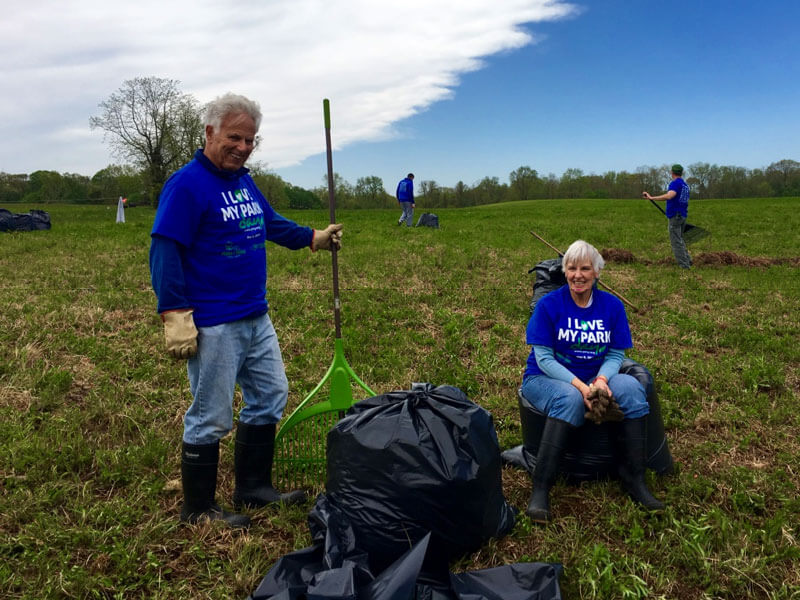
Volunteers raking cut vegetation off the field in early May.
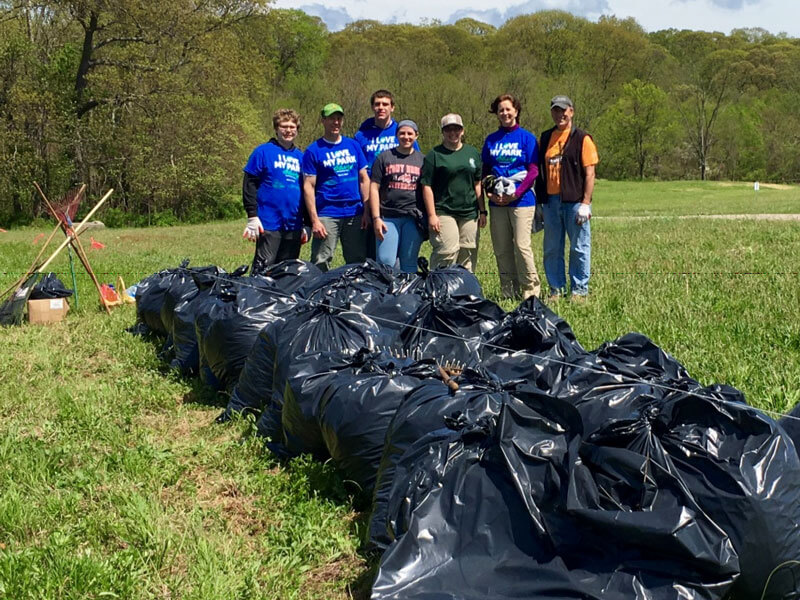
More volunteers raking cut vegetation off the field in early May.
Growing Season
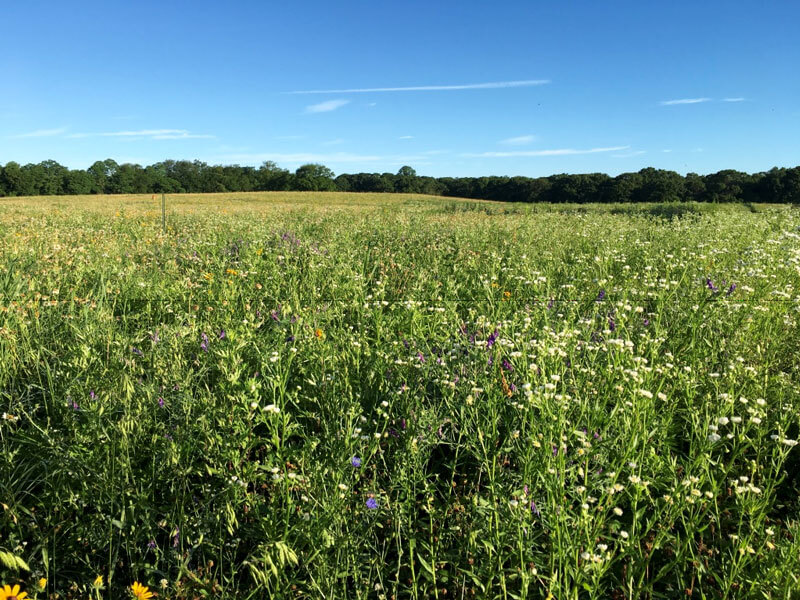
June 25th vegetation
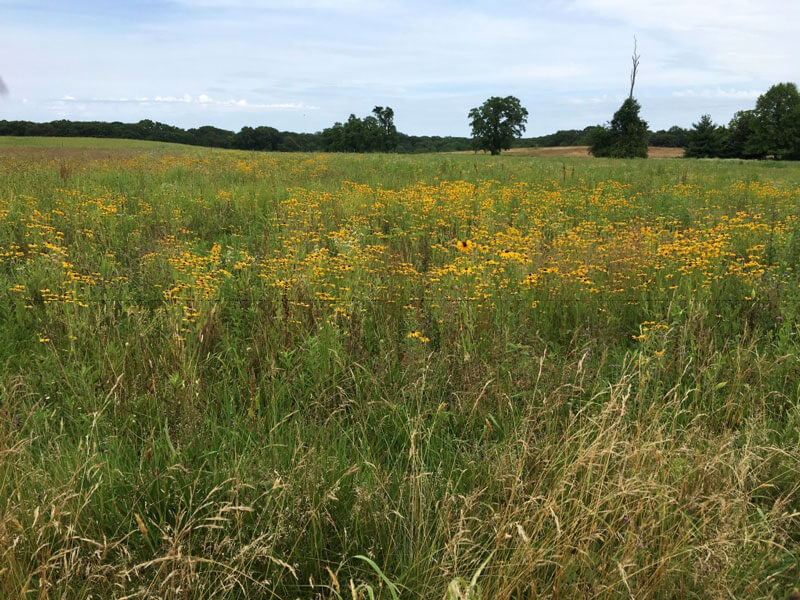
July 6th vegetation
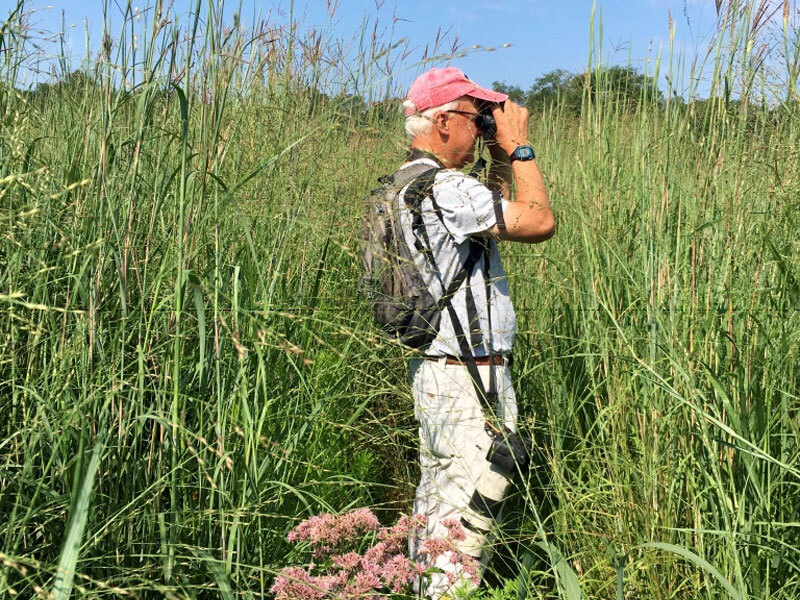
August 10th vegetation
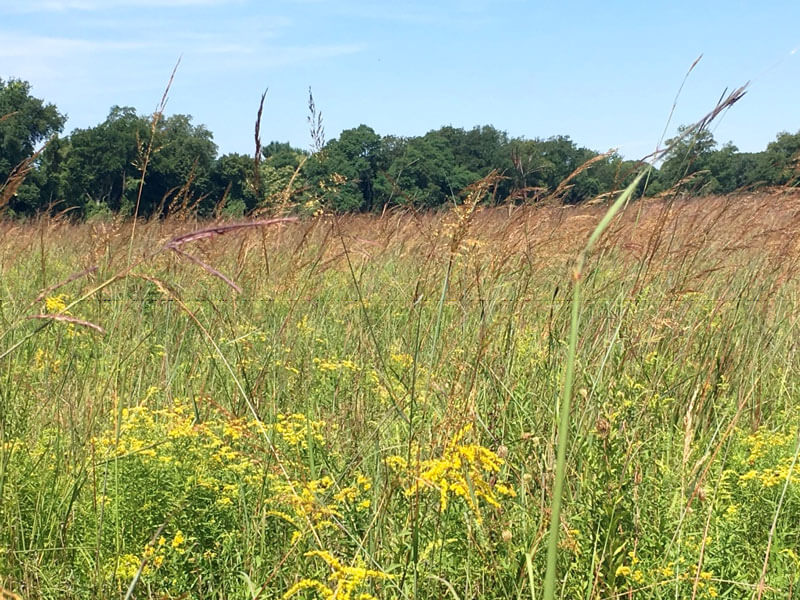
August 31st vegetation.
Vegetation Transect Results
Vegetation transects were conducted during June and July. The survey consisted of 3 transect lines with a total of 47 stations. Percent composition was estimated in a meter square quadrant every 50 feet.
Data gathered and analyzed for both transect periods indicates the following:
- A higher percentage of native vegetation compared with invasive species.
- Woody vegetation was minimal and consisted primarily of black locust and multiflora rose.
- The percent composition of all identified invasives in June was 0.74% and in July, 0.84%.
Native vs. Invasive Vegetation
While native vegetation maintains a higher percent composition than invasive forbs and woodies in the restoration site, field observations would argue that the presence of invasives maybe greater than transect data suggests. For example, although no woodies were found within the transect samples or along the transect lines, several multiflora rose were located within the south area of the site. It is likely that additional woody vegetation is scattered within the 30-acre site. In addition, small isolated areas of invasive forbs such as Canada thistle and mugwort exist outside of the transect area. Given these findings yearly monitoring and removal of these plants should be continued.
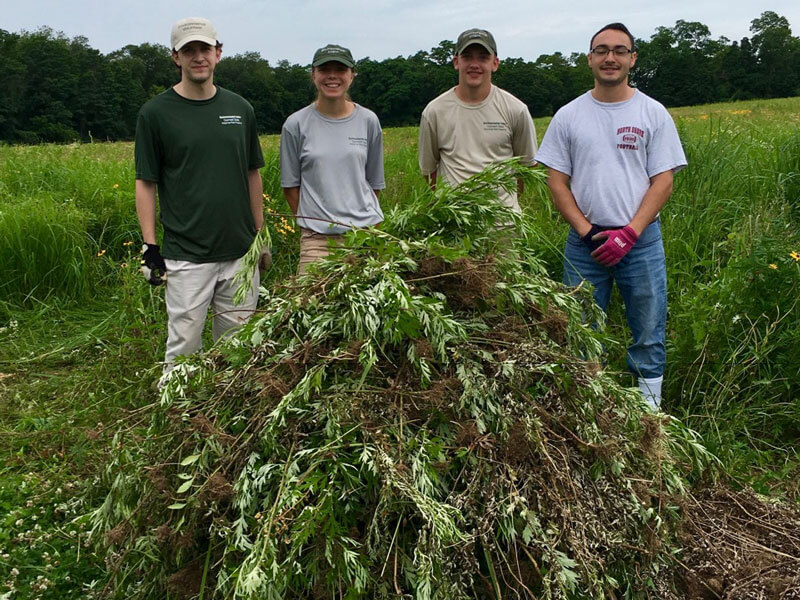
Summer Environmental interns and volunteers in back of Mugwort pile.
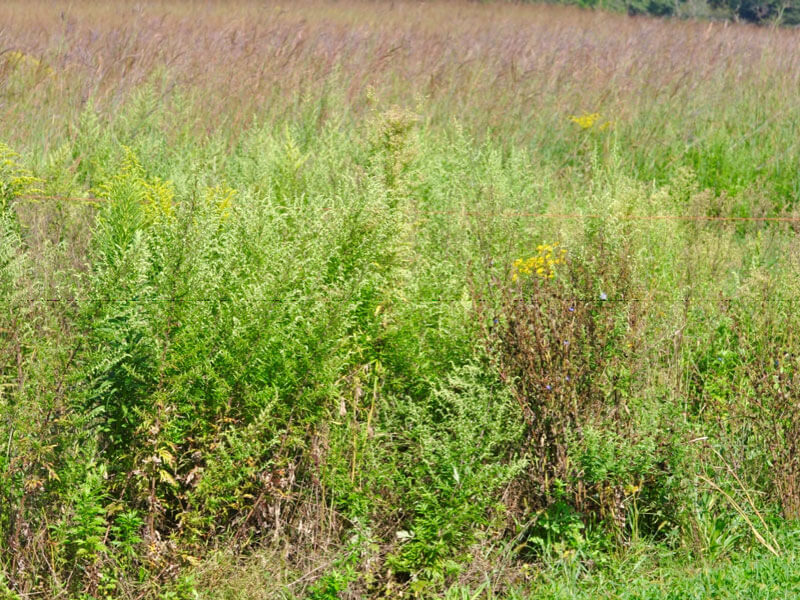
Mugwort growing on field edge alongside Goldenrod.
Invasive Species
Despite the success of warm season grasses in comparison to other vegetation, there remains problematic areas of invasive plants including mugwort (Artemisia vulgaris), Canada thistle (Cirsium arvense), and mile-a-minute (Persicaria perfoliata). These species were difficult to manage and control due to their location within the field, physical characteristics and removal method. Mugwort is thought to be an allelopathic species that colonizes an area through an extensive root system and eliminates native species through its expulsions of chemicals inhibiting native seed germination. Mugwort was most extensive in the southeast section of the restoration field and smaller patches in other locations. Canada thistle, like mugwort, was found throughout the field but was mainly located southwest of the Hickory trees. Moreover, mile-a-minute (MAM), was found primarily east of the hickory trees extending west to east often referred to as the “hickory shadow”. MAM was also found along the northwest border of the field during the month of September. Canada thistle was difficult to remove because of its prickly exterior, as well as its fluffy seed head that was hard to manage under windy conditions.
Transect Data
In June, cool season grasses occupied a substantial percentage of the sampled vegetation and by mid-July native warm season grasses emerged and dominated the vegetation composition. At the end of July the warm season grasses of big bluestem (Andropogon gerardii), little bluestem (Schizachyrium scoparium), indiangrass (Sorghastrum nutans), and switchgrass (Panicum virgatum) represented 54.66% of the sampled vegetation.
% Composition Transect Results of July 26, 2017
Warm Season Grasses
Forbs
Invasives
Open Soil
Warm season grasses had the largest percent composition in July at times tripling the amount of forbs and dominating the invasive species. Although collected data did not measure the percent composition of the individual warm season grass species, field inspections indicate that big bluestem was the dominant grass in most of the field during the month of August. In late August and early September large areas of Indiangrass dominated the southern and northern areas of the field. Little bluestem was found in higher concentrations in the hilly northern section of the field that had experience erosion during the August of 2014.
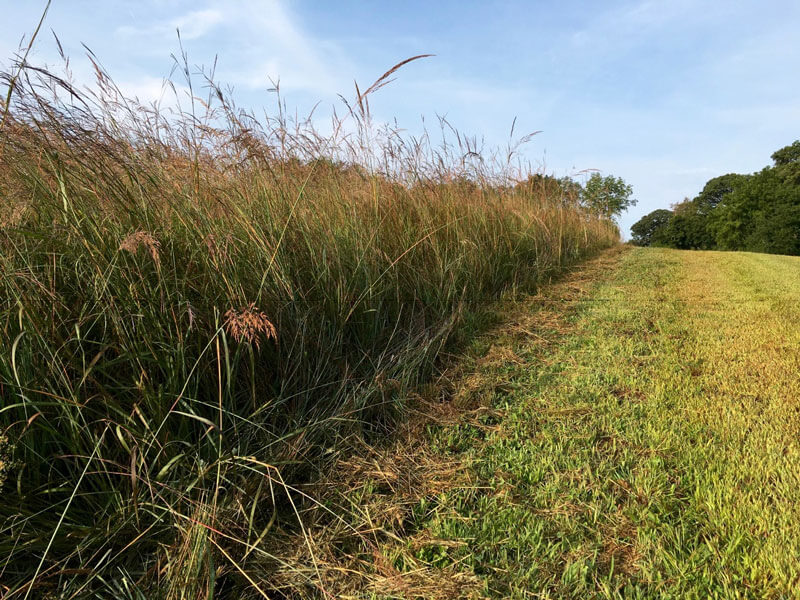 Northern edge of Restoration Field on September 12th.
Northern edge of Restoration Field on September 12th.
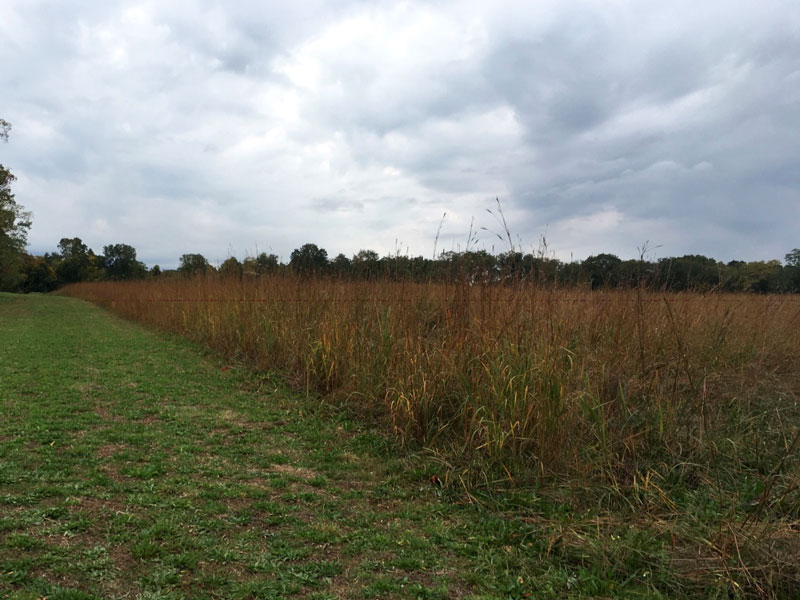 Eastern perimeter of Restoration Field on October 25, 2017.
Eastern perimeter of Restoration Field on October 25, 2017.
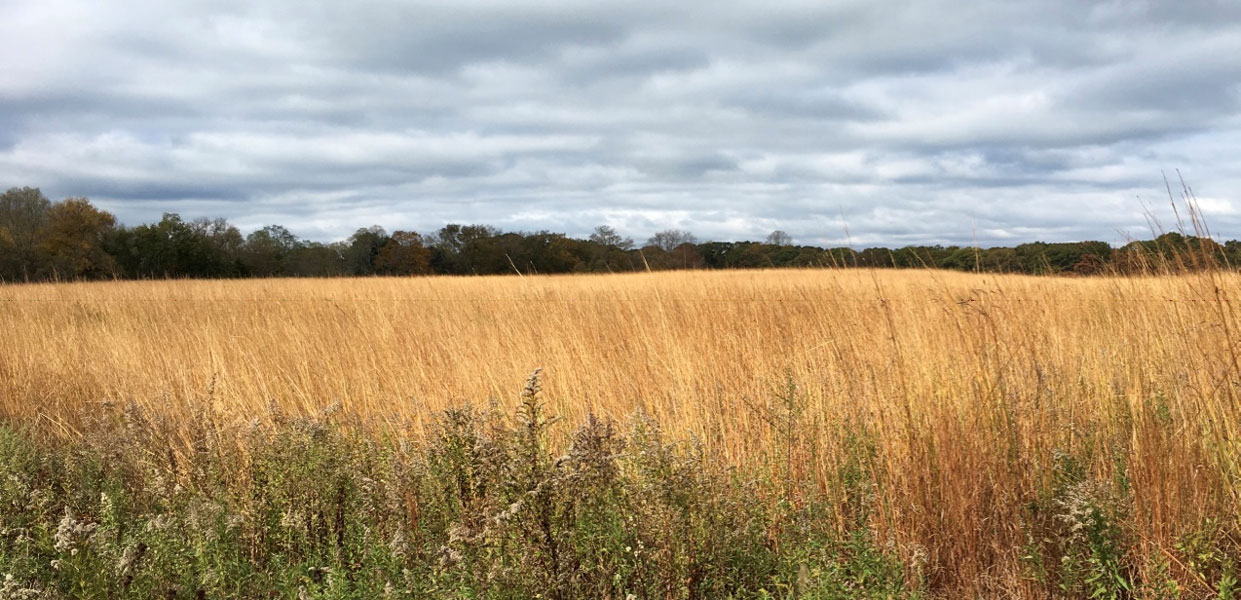 Looking northeast across the Restoration Field on November 8, 2017.
Looking northeast across the Restoration Field on November 8, 2017.
2017 Plant list in Restoration Site by monthly occurrence.
| Common Name | Scientific name | Month |
|---|---|---|
| Alsike Clover | Trifolium hybridum | June, July |
| Bedstraw | Galium sp | June |
| Big Blue Stem Grass | Andropogon gerardi | July, August |
| Black Cherry | Prunus serotina | June, July, August |
| Black Eyed Susan | Rudbeckia hirta | June, July, August |
| Black Locust | Robinia pseudocacia | July, August |
| Blue-eyed Grass | Sisyrinchium sp | June |
| Butter and Eggs | Linaria vulgaris | June, July, August |
| Butterfly Weed | Asclepius tuberose | June, July |
| Canada Goldenrod | Solidago altissima | August |
| Canada Thistle | Cirsium arvense | June, July, August |
| Chicory | Cichorium intybus | June, July, August |
| Cinquefoil | Potentilla sp | June |
| Common Evening Primrose | Oenothera biennia | June |
| Common Milkweed | Aclepias syriaca | June, July, August |
| Common Mullen | Verbascum thapsus | June |
| Common Plantain | Plantago major | June |
| Cow Vetch | Vicia cracca | June, July |
| Curled Dock | Rumex crispus | June, July, August |
| Daisy Fleabane | Erigeron annuus | June, July |
| Early Goldenrod | Solidago juncea | August |
| English Plantain | Platago lanceolata | June, July, August |
| Hawthorn | Crataegus sp | June |
| Joe-Pye Weed | Eupatorium sp | July, August |
| Lance-leaved Goldenrod | Solidago graminifolia | August |
| Little Blue Stem Grass | Schizachyrium scoparium | July, August |
| Mile-A-Minute | Persicania perfoliata | June, July, August |
| Mint | Mentha sp | June |
| Mugwort | Artemisia vulgaris | June, July, August |
| Oxeye Daisy | Leucantemum vulgare | June, July |
| Pokeweed | Phytolacca americana | June, July, August |
| Purple Love Grass | Ergots Spectabilis | June, July |
| Purple Top Grass | Tridens flavus | July, August |
| Queen Anne’s Lace | Daucus carota | July, August |
| Red Clover | Trifolium pratense | June, July, August |
| Rough-stemmed Goldenrod | Solidago rugosa | August |
| Showy Goldenrod | Solidago speciosa | August |
| Spiderwort | Tradescantia sp | June |
| Switch Grass | Panicum virgatum | July, August |
| Venus Looking Glass | Specularia perfoliata | June |
| Wild Basil | Satureja vulgare | June, July, August |
| Wild Madder | Galium sp | June |
| Yarrow | Archillea millefolium | June |
Grassland Restoration Project Phases
- Project Overview
- Phase 1 - September through November 2011
- Phase "1.5" - Summer 2012
- Phase 2 - December 2012 through September 2013
- Phase 3 - March 2014 through Spring 2015
- Second Year of Establishment 2016
- Third Year of Establishment 2017
- Fourth Year of Establishment 2018
- Aerial Photos of Field
- Grassland Management Plan
- Vegetation Survey Report of Grassland Restoration Field
